Anticlerical Motifs in the Illustrations of Martin Luther’s Hauspostille
Abstract
:1. Introduction: The Disappearing Demon and Anticlerical Threads in the First Decades of the Reformation
2. Cycles in Early Modern Postils
3. Vom Berg and Neuber’s Two Sets of Matrices
3.1. Square Blocks First Used in 1544
3.2. Rectangular Blocks First Used in 1545
4. Selection Criteria: Uses of Two Sets between 1544 and 1548
4.1. Accumulation, Elimination, and Replacement
4.2. Nuremberg between 1544 and 1548
5. Aftermath: Further Cycles and Reuses after 1548
Author Contributions
Funding
Conflicts of Interest
Appendix A. Illustrations in Selected Editions of the Hauspostille of 1544, 1545, 1548 and 1549
| Older blocks | |
| Square blocks first used in 1544; [S no] = square block number | |
| Rectangular blocks first used in 1545; [R no] = rectangular block number | |
| Brosamer’s 1544 blocks first used in Nuremberg in 1549; [H no] = block number (after Knauer 2015) |
| Feast | Pericope | Luther 1544b | Luther 1545a | Luther 1548 | Luther 1549 |
| Winter postil | |||||
| 1st Sunday of Advent | Mt 21: 1–9 | Entry to Jerusalem [S 1], fol. Iv | Entry to Jerusalem [R 1], fol. Iv | Entry to Jerusalem [R 1], fol. Iv | Entry to Jerusalem, fol. Iv |
| 2nd Sunday of Advent | Lk 21: 25–33 | Prophecy of the Last Judgment [S 2], fol. IV | Prophecy of the Last Judgment [R 2], fol. IVv | Prophecy of the Last Judgment [R 2], fol. IVv | Prophecy of the Last Judgment [H 1001], fol. V |
| 3rd Sunday of Advent | Mt 11: 2–10 | St John the Baptist in prison [S 3], fol. VII | St John, the Baptist in prison [R 3], fol. VIIIv | St John, the Baptist in prison [R 3], fol. VIIIv | St John, the Baptist in prison [H 1002], fol. IX |
| 4th Sunday of Advent | J 1: 19–28 | St John baptizing [S 4], fol. X | St John baptizing [R 4], fol. XIIv | St John baptizing [R 4], fol. XIIv | St John baptizing [H 1003], fol. XIIIv |
| Nativity of Christ | Lk 2: 1–14 | Nativity of Christ [S 5], fol. XIII | Nativity of Christ [R 5], fol. XVIv | Nativity of Christ [R 5], fol. XVIv | Nativity of Christ [H 1004], fol. XVIIv |
| Adoration of the Shepherds [H 1005], fol. XXIX | |||||
| Sunday after Nativity | Lk 2: 33–40 | Presentation of Christ [S 6], fol. XXIV | Presentation of Christ [R 6], fol. XXXI | Presentation of Christ [R 6], fol. [X]XXI | Presentation of Christ [H 1009], fol. XXXII |
| Circumcision | Lk 2: 21 | Circumcision, fol. XXVIIIv | Circumcision [R 7], fol. XLv | Circumcision [R 7], fol. XLv | Circumcision [H 1010], fol. XLII |
| Epiphany | Mt 2: 1–12 | Adoration of the Magi [S 7], fol. XXXIIIv | Adoration of the Magi [R 8], fol. XLIII | Adoration of the Magi [R 8], fol. XLIII | Adoration of the Magi [H 1011], fol. XLV |
| Mt 3: 13–17 | Baptism of Christ [S 8], fol. XXXVIIv | Baptism of Christ [R 9], fol. XLVIII | Baptism of Christ [R 9], fol. XLVIII | Christ talking to Nicodemus and St John baptizing [H 1039], fol. L | |
| 1st Sunday after Epiphany | Lk 2: 42–52 | Twelve-years-old Christ in the Temple [S 9], fol. XLv | Twelve-years-old Christ in the Temple [R 10], fol. LIv | Twelve-years-old Christ in the Temple [R 10], fol. LIv | Twelve-years-old Christ in the Temple [H 1012], fol. LIIIv |
| 2nd Sunday after Epiphany | J 2: 1–11 | Marriage at Cana [S 10], fol. XLIII | Marriage at Cana [R 11], fol. LIVv | Marriage at Cana [R 11], fol. LIVv | Marriage at Cana [H 1013], fol. LVII |
| 3rd Sunday after Epiphany | Mt 8: 1–13 | Centurion of Capernaum [S 11], fol. XLVv | Centurion of Capernaum [R 12], fol. LVIII | Centurion of Capernaum [R 12], fol. LVIII | Centurion of Capernaum [H 1014], fol. LXI |
| 4th Sunday after Epiphany | Mt 8: 23–27 | Christ calming the storm [S 12], fol. XLVIIIv | Christ calming the storm [R 13], fol. LXIv | Christ calming the storm [R 13], fol. LXIv | Christ calming the storm [H 1015], fol. LXIVv |
| 5th Sunday after Epiphany | Mt 13: 24–30 | Parable of the tares [S 13], fol. LIv | Parable of the tares [R 14], fol. LXV | Parable of the tares [R 14], fol. LXV | Parable of the tares [H 1016] |
| Sunday Septagesimae | Mt 20: 1–16 | Parable of the workers in the vineyard [S 14], fol. LIV | Parable of the workers in the vineyard [R 15], fol. LXIX | Parable of the workers in the vineyard [R 15], fol. LXIX | Parable of the workers in the vineyard [H 1017], fol. LXXIv |
| Sunday Sexagesimae | Lk 8: 5–15 | Parable of the sower [S 15], fol. LVII | Parable of the sower [R 16], fol. LXXII | Parable of the sower [R 16], fol. LXXII | Parable of the sower [H 1018], fol. LXXVv |
| Purification of Mary | Lk 2: 22–24 | Presentation of Christ [S 6], fol. LX | Presentation of Christ [R 6], fol. CXXVv | Presentation of Christ [R 6], fol. CXXVv | Presentation of Christ [H 1009], fol. LXXIX |
| Sunday Quinquagesimae | Lk 18: 31–43 | Healing of the blind man of Jericho [S 16], fol. LXVIv | Healing of the blind man of Jericho [R 17], fol. LXXXIIIv | Healing of the blind man of Jericho [R 17], fol. LXXXIIIv | Healing of the blind man of Jericho [H 1019], fol. LXXXVIIv |
| 1st Sunday of Lent | Mt 4: 1–11 | Temptation of Christ [S 17], fol. LXIXv | Temptation of Christ [R 18], fol. LXXXVII | Temptation of Christ [R 19], fol. LXXXVII | Temptation of Christ [H 1020], fol. XCI |
| 2nd Sunday of Lent | Mt 15: 21–28 | Christ and the Canaanite woman [S 18], fol. LXXIIv | Christ and the Canaanite woman [R 19], fol. XCv | Christ and the Canaanite woman [R 19], fol. XCv | Christ and the Canaanite woman [H 1021], fol. XCV |
| 3rd Sunday of Lent | Lk 11: 14–28 | Christ healing a demoniac [S 19], fol. LXXIVv | Christ healing a demoniac [R 20], fol. XCIIIv | Christ healing a demoniac [R 20], fol. XCIIIv | Christ healing a demoniac [H 1022], fol. XCVIII |
| 4th Sunday of Lent | J 6: 1–15 | Feeding the multitude [S 20], fol. LXXVIIIv | Feeding the multitude [R 21], fol. XCVIIIv | Feeding the multitude [R 21], fol. XCVIIIv | Feeding the multitude [H 1023], fol. CIII |
| 5th Sunday of Lent | J 8: 46–59 | Christ and the Pharisees (taxes) [S 21], fol. LXXXII | Christ and the Pharisees [R 22], fol. CIIv | Christ and the Pharisees [R 22], fol. CIIv | Attempt to stone Christ [H 1024], fol. CVIIv |
| Palm Sunday | 1Cor 11: 23–261 | Comunion and procession [S 22], fol. LXXXIVv | Comunion and procession [S 22], fol. CVI | Comunion and procession [S 22; state II], fol. CVI | Comunion and procession [S 22, state II], fol. CXI |
| Maundy Thursday | J 13: 1–17 | Christ washing the feet of the disciples [S 23], fol. LXXXIXv | Christ washing the feet of the disciples [S 23], fol. CXII | Christ washing the feet of the disciples [S 23], fol. CXII | Christ washing the feet of the disciples [S 23], fol. CXVII |
| Passion | |||||
| 1st Sermon | Lk 23: 32–43 | Crucifixion (after Cranach), fol. XCVIIIv | Agony in the garden [R 23], fol. CXXIII | Agony in the garden [R 23], fol. CXXIII | Agony in the garden [R 23], fol. CXXVIII |
| 3rd Sermon | Arrest of Christ [R 24], fol. CXXXIv | Arrest of Christ [R 24], fol. CXXXIv | Arrest of Christ [R 24], fol. CXXXVIv | ||
| 4th Sermon | Christ before Caiphas [R 25], fol. CXXXV | Christ before Caiphas [R 25], fol. CXXXV | Christ before Caiphas [R 25], fol. CXLv | ||
| 6th Sermon | Christ before Pilate [R 26], fol. CXLI | Christ before Pilate [R 26], fol. CXLI | Christ before Pilate [R 26], fol. CXLVIv | ||
| 9th Sermon | Christ carrying the cross [R 27], fol. CLIIv | Christ carrying the cross [R 27], fol. CLIIv | Christ carrying the cross [R 27], fol. CLVIII | ||
| 10th Sermon | Christ nailed to the cross [R 28], fol. CLVIv | Crucifixion [R 29], fol. CLVIv | Crucifixion [R 29], fol. CLXII | ||
| 11th Sermon | Crucifixion [R 29], fol. CLXIv | Crucifixion [R 29], fol. CLXIv | Crucifixion [R 29], fol. CLXVII | ||
| 13th Sermon | Lamentation [R 30], fol. CLXVIv | ||||
| Summer postil | |||||
| Easter Sunday | Mt 28: 1–9 | The three Maries at the tomb [S 24], fol. CII | Risen Christ [R 31], fol. II | Risen Christ [R 31], fol. II | The three Maries at the tomb [H 1026], fol. II |
| The three Maries at the tomb [R 32], fol. VI | Christ appearing on the road to Emmaus [H 1027], fol. VI | ||||
| Lk 24: 13–35 | Risen Christ appearing to the Apostles [H 1028], fol. IXv | ||||
| 1st Sunday after Easter | J 20: 19–31 | Incredulity of Thomas [S 25], fol. XXVII | Incredulity of Thomas [S 25], fol. CXI | Incredulity of Thomas [R 33], fol. XII | Incredulity of Thomas [H 1029], fol. XIIIv |
| 2nd Sunday after Easter | J 10: 11–16 | Parable of the good Shepherd [S 26], fol. CXV | Parable of the good Shepherd [R 34], fol. XVIII | Parable of the good Shepherd [R 34], fol. XVII | Parable of the good shepherd [H 1030], fol. XVIIIv |
| 3rd Sunday after Easter | J 16: 16–23 | Christ with disciples [S 27], fol. CXVIII | Christ with disciples [R 35], fol. XXII | Christ with disciples [R 35], fol. XXII | Christ with disciples [H 1031], fol. XXIIv |
| 4th Sunday after Easter | J 16: 5–15 | Christ with disciples [S 28], fol. CXXI | Christ with disciples [R 36], fol. XXVv | Christ with disciples [R 36], fol. XXIX | Christ with disciples [H 1032], fol. XXX |
| 5th Sunday after Easter | J 16: 23–30 | Christ with disciples [S 29], fol. CXXV | Christ with disciples [R 37], fol. XXX | Christ with disciples [R 37], fol. XXXIIIv | Christ preaching [H 1033], fol. XXXV |
| Ascension | Mt 16: 14–20 | Ascension [S 30], fol. CXX[VIII] | Ascension [R 38], fol. XXXIIIv | Ascension [R 38], fol. XXXVIIv | Ascension [H 1034], fol. XXXIX |
| 6th Sunday after Easter | J 15: 26–16,4 | Christ with disciples [S 27], fol. CXXXIv | Christ with disciples [R 36], fol. XXXVIIv | Christ with disciples [R 36], fol. XLI | Christ with disciples [H 1035], fol. XLIII |
| Pentecost Sunday | J 14: 21–31 | Pentecost [S 31], fol. CXXXV | Pentecost [R 39], fol. XLIv | Pentecost [R 39], fol. XLV | Pentecost [H 1036], fol. XLVII |
| Pentecost Monday | J 3: 16–21 | Crucifixion, fol. CXL | Crucifixion [R 29], fol. XLVIIv | Crucifixion [R 29], fol. Liv | Christ talking to Nicodemus [H 1037], fol. LIIIv |
| Holy Trinity | J 3: 1–14 | Holy Trinity (Creation of Adam, Crucifix and Pentecost) [S 32], fol. CXLIV | Holy Trinity (Creation of Adam, Crucifix and Pentecost) [S 32], fol. LII | Holy Trinity (Creation of Adam, Crucifix and Pentecost) [S 32], fol. LVI | Christ talking to Nicodemus and St John baptizing [H 1039], fol. LVIII |
| Holy Trinity | Christ talking to Nicodemus [S 33], fol. CXLVIIIv | Christ talking to Nicodemus [R 40], fol. LVII | Christ talking to Nicodemus [R 40], fol. LXI | Christ talking to Nicodemus and St John baptizing [H 1039], fol. LXIIIv | |
| 1st Sunday after Trinity | Lk 14: 16–24 | Parable of the great banquet [S 34], fol. CLIII | Parable of the great banquet [R 41], fol. LXIIv | Parable of the great banquet [R 41], fol. LXVIIv | Parable of the great banquet [H 1041], fol. LXIX |
| 2nd Sunday after Trinity | Lk 16: 19–31 | Parable of Lazarus and the rich man [S 35], fol. CLVIII | Parable of Lazarus and the rich man [R 42], fol. LXXXVIv | Parable of Lazarus and the rich man [R 42], fol. LXXIII | Parable of Lazarus and the rich man [H 1040], fol. LXXVv |
| 3rd Sunday after Trinity | Lk 15: 1–10 | Parable of the lost sheep [S 36], fol. CLXIv | Parable of the lost sheep [R 43], fol. LXXIIv | Healing a paralytic [R 57], fol. LXXVIIv | Parable of the lost sheep [H 1042], fol. LXXX |
| 4th Sunday after Trinity | Lk 6: 36–42 | The parable of the speck and the log [S 37], fol. CLXV | The parable of the speck and the log [R 44], fol. LXXVI | The parable of the speck and the log [R 44], fol. LXXXI | The parable of the speck and the log [H 1043], fol. LXXXIV |
| 5th Sunday after Trinity | Lk 5: 1–11 | Christ preaching in a ship [S 38], fol. CLXIXv | Christ preaching in a ship [R 45], fol. LXXXIv | Christ preaching in a ship [R 45], fol. LXXXVIv | Christ preaching in a ship [H 1044], fol. XC |
| 6th Sunday after Trinity | Mt 5: 20–26 | Christ preaching [S 39], fol. CLXXIIIv | Christ preaching [R 46], fol. LXXXVIv | Christ preaching [R 46], fol. XCIv | Christ preaching [H 1045], fol. CXV |
| 7th Sunday after Trinity | Mt 8: 1–9 | Feeding the multitude [S 40], fol. CLXXVII | Feeding the multitude [R 21], fol. XCv | Feeding the multitude [R 21], fol. XCV | Feeding the multitude [H 1046], fol. XCXIXv |
| 8th Sunday after Trinity | Mt 7: 15–23 | Warning against false prophets [S 41], fol. CLXXX | Warning against false prophets [S 41], fol. XCIVv | Christ with disciples [R 34], fol. XCIXv | Warning against false prophets [H 1047], fol. CIIIv |
| 9th Sunday after Trinity | Lk 16: 1–9 | Parable of the unjust steward [S 42], fol. CLXXXIIIv | Parable of the unjust steward [R 47], fol. XCIX | Parable of the unjust steward [R 47], fol. CIV | Parable of the unjust steward [H 1048], fol. CVIII |
| 10th Sunday after Trinity | Lk 19: 41–48 | Cleansing of the temple [S 43], fol. CXXXVIv | Siege of the church [R 48], fol. CIII | Siege of the church [R 48], fol. CVIII | Cleansing of the temple [H 1049], fol. CXIIv |
| 11th Sunday after Trinity | Lk 18: 9–14 | Parable of the Pharisee and the tax collector [S 44], fol. CXCv | Parable of the Pharisee and the tax collector [R 49], fol. CVIII | Parable of the Pharisee and the tax collector [R 49], fol. CXIII | Parable of the Pharisee and the tax collector [H 1050], fol. CXVIIv |
| 12th Sunday after Trinity | Mt 7: 31–37 | Healing of a deaf and dumb man [S 45], fol. CXCIII | Healing of a deaf and dumb man [R 50], fol. CXI | Healing of a deaf and dumb man [R 50], fol. CXVI | Healing of a deaf and dumb man [H 1051], fol. CXXI |
| 13th Sunday after Trinity | Lk 10: 22–37 | Parable of the good Samaritan [S 46], fol. CXCVv | Parable of the good Samaritan [R 51], fol. CXIV | Parable of the good Samaritan [R 51], fol. CXIX | Parable of the good Samaritan [H 1052], fol. CXXIV |
| 14th Sunday after Trinity | Lk 17: 11–19 | Healing the ten lepers [S 47], fol. CXCIX | Healing a leper [R 52], fol. CXIXv | Healing a leper [R 52], fol. CXXIVv | Healing the ten lepers [H 1053], fol. CXXIXv |
| 15th Sunday after Trinity | Mt 6: 24–34 | Earthly versus heavenly treasures [S 48], fol. CCIv | Earthly versus heavenly treasures [R 53], fol. CXXIIv | Earthly versus heavenly treasures [R 53], fol. CXXVIIv | Earthly versus heavenly treasures [H 1054], fol. CXXXIII |
| 16th Sunday after Trinity | Lk 7: 11–17 | Raising of the son of a widow in Nain [S 49], fol. CCVv | Raising of the son of a widow in Nain [R 54], fol. CXXVIIv | Raising of the son of a widow in Nain [R 54], fol. CXXXIIv | Raising of the son of a widow in Nain [H 1055], fol. CXXXVIIIv |
| 17th Sunday after Trinity | Lk 14: 1–11 | Healing a sick man on the Sabbath [S 50], fol. CCVIIIv | Healing a sick man on the Sabbath [R 55], fol. CXXXv | Healing a sick man on the Sabbath [R 55], fol. CXXXVv | Healing a sick man on the Sabbath [H 1056], fol. CXIIv |
| 18th Sunday after Trinity | Mt 22: 34–46 | Christ and the Pharisees [S 51], fol. CCXv | Christ and the Pharisees [R 56], fol. CXXXIIIv | Christ and the Pharisees [R 56], fol. CXXXVIIIv | Christ and the Pharisees (The tribute to be paid to Caesar) [H 1057], fol. CXLIVv |
| 19th Sunday after Trinity | Mt 9: 1–8 | Healing a paralytic [S 49], fol. CCXIV | Healing a paralytic [R 57], fol. CXXXVIIv | Healing a paralytic [R 57], fol. CXLIII | Healing a paralytic [H 1058], fol. CXLIX |
| 20th Sunday after Trinity | Mt 22: 1–14 | Parable of the wedding banquet [S 52], fol. CCXVIIv | Parable of the wedding banquet [R 58], fol. CXLIv | Parable of the wedding banquet [R 58], fol. CXLVII | Parable of the wedding banquet [H 1059], fol. CLIIIv |
| 21th Sunday after Trinity | J 4: 46–54 | Healing of an official’s son [S 53], fol. CCXXIv | Healing of an official’s son [R 50], fol. CXLVIv | Healing of an official’s son [R 59], fol. CLIIv | Healing of an official’s son [H 1060], fol. CLIX |
| 22th Sunday after Trinity | Mt 18: 23–35 | Parable of the unmerciful servant [S 54], fol. CCXXIVv | Parable of the unmerciful servant [R 60], fol. CLv | Parable of the unmerciful servant [R 60], fol. CLVI | Parable of the unmerciful servant [H 1061], fol. CLXIII |
| 23th Sunday after Trinity | Mt 22: 15–22 | Christ and the Pharisees [S 21], fol. CCXXVIII | Christ and the Pharisees [R 22], fol. CLIVv | Christ and the Pharisees [R 22], fol. CLXv | Christ and the Pharisees (The tribute to be paid to Caesar) [H 1057], fol. CLXVIIv |
| 24th Sunday after Trinity | Mt 9: 18–26 | Healing the bleeding woman [S 55], fol. CCXXXIv | Healing the bleeding woman and Jair’s daughter [R 61], fol. CLIX | Healing the bleeding woman and Jair’s daughter [R 61], fol. CLXIVv | Healing the bleeding woman and Jair’s daughter [H 1062], fol. CLXXII |
| 25th Sunday after Trinity | Mt 24: 15–28 | Christ with disciples [S 28], fol. CCXXXV | Christ with disciples [R 35], fol. CLXIII | Christ with disciples [R 35], fol. CLXIX | Christ foretelling the destruction of the Temple [H 1063], fol. CLXXVIv |
| 26th Sunday after Trinity | [J 6: 1–15]2 | [fol. CCXXXVIIIv; ref. to 4th Sunday of Lent] | [fol. CLXVIIv, ref. to 4th Sunday of Lent] | [fol. CLXXIIIv, ref. to 4th Sunday of Lent] | [fol. CLXXXI, ref. to 4th Sunday of Lent] |
| 27th Sunday after Trinity | Mt 5: 1–12 | Sermon on the mount [S 56], fol. CCXXXVIIIv | Christ with disciples [R 34], fol. CLXVIIv | Christ with disciples [R 35], fol. CLXXIIIv | Christ with disciples [H 1031], fol. CLXXXI |
| Festival postil | |||||
| St Andrew | Mt 4: 18–22 | Calling of St Peter and St Andrew [S 57], fol. II | Calling of St Peter and St Andrew [S 57], fol. II | Calling of St Peter and St Andrew [S 57], fol. II | Christ calming the storm [H 1015], fol. II |
| St Thomas | J 20: 24–29 | Incredulity of Thomas [S 25], fol. Vv | Incredulity of Thomas [R 33], fol. VI | Incredulity of Thomas [R 33], fol. VI | Incredulity of Thomas [H 1029], fol. VIv |
| Christmas Eve | Lk 2: 1–13 | Nativity of Christ [S 5], fol. VIII | Nativity of Christ [R 5], fol. IX | Nativity of Christ [R 5], fol. IX | Adoration of the Shepherds [H 1005], fol. X |
| St Stephen | Acts 6: 1–7: 603 | Stoning of St Stephen [S 58], fol. XIIv | Stoning of St Stephen [S 58], fol. XIV | [empty square space], fol. XIV | Christ and the Pharisees and stoning of a prophet [H 1007], fol. XV |
| Massacre of the Innocents | Mt 2: 13–18 | Massacre of the innocents [S 59], fol. XVII | Massacre of the innocents [S 59], fol. XX | Massacre of the innocents [S 59], fol. XX | Massacre of the innocents [S 59], fol. XXI |
| Epiphany | Mt 2: 1–12 | Adoration of the Magi [S 7], fol. XXv | Adoration of the Magi [R 7], fol. XXIIIv | Adoration of the Magi [S 7], fol. XXIIIv | Adoration of the Magi [H 1011], fol. XXIVv |
| Conversion of St Paul | Acts 9: 1–254 | Conversion of St Paul [S 60], fol. XXIII | Conversion of St Paul [S 60], fol. XXVII | Conversion of St Paul [S 60], fol. XXVII | Conversion of St Paul [S 60], fol. XXVIII |
| St Mathias | Mt 11: 25–30 | Christ preaching and Catholic hierarchs [S 61], fol. XXVIv | Christ preaching and Catholic hierarchs, fol. XXXI | [empty square space], fol. XXXI | Christ preaching [H 1033], fol. XXXII |
| Annunciation | Lk 1: 26–38 | Annunciation [S 62], fol. XXIXv | Annunciation [S 62], fol. XXXIVv | Annunciation [S 62], fol. XXXV | Annunciation [S 62], fol. XXXVIv |
| St Philipp and Jacob | J 14: 1–14 | [no illustration], fol. XXXIV | Two Kingdoms [S 68], fol. XL | Two Kingdoms [S 68], fol. XL | Christ with disciples [H 1035], fol. XLIv |
| Nativity of St John the Baptist | Lk 1: 57–80 | Zechariah at the altar of Incense [S 63], fol. XXXVIII | Zechariah at the altar of Incense [S 63], fol. XLV | Zechariah at the altar of Incense [S 63], fol. XLVv | Circumcision [of St John the Baptist] [H 1010], fol. XLVIIv |
| Beheading of St John the Baptist | Mt 6: 17–29 | Beheading of St John the Baptist [S 64], fol. LXV5 | Beheading of St John the Baptist [S 64], fol. LIv | Beheading of St John the Baptist [S 64], fol. LIv | Beheading of St John the Baptist [S 69], fol. LIIIv |
| St Peter and Paul | Mt 16: 13–19 | Adoration of the Crucifix and Catholic hierarchs [S 65], fol. XLIII | Adoration of the Crucifix and Catholic hierarchs [S 65], fol. LIVv | Christ with disciples [R 34], fol. LV | Christ with disciples [H 1031], fol. LVII |
| St Mary Magdalene | Lk 7: 36–50 | Sinner anointing Christ’s feet [S 66], fol. XLVII | Sinner anointing Christ’s feet [S 66], fol. LX | Sinner anointing Christ’s feet [S 66], fol. LX | Sinner anointing Christ’s feet [S 65], fol. LXII |
| St James the Elder | Mk 10: 35–456 | Christ rebukes the sons of Zebedee [S 67], fol. LI | Christ rebukes the sons of Zebedee [S 67], fol. LXV | Christ rebukes the sons of Zebedee [S 67], fol. LXVv | Christ rebukes the sons of Zebedee [S 66], fol. LXVIIv |
| Visitation | Lk 1: 39–56 | Visitation [S 68], fol. LIVv | Visitation [S 68], fol. LXVIIIv | Visitation [S 68], fol. LXIX | Visitation [S 67], fol. LXXIv |
| St Bartholomew | Lk 22: 24–307 | Two Kingdoms [S 69], fol. LXII | Two Kingdoms [S 69], fol. LXXVIII | Two Kingdoms [S 69], fol. LXXVIIIv | Christ with disciples [H 1031], fol. LXXXv |
| St Matthew | Mt 9: 9–13 | Calling of St Matthew [S 70], fol. LXVIIv | Calling of St Matthew [S 70], fol. LXXXI | Calling of St Matthew [S 70], fol. LXXXIv | Calling of St Matthew [S 70], fol. LXXXIV |
| St Michael | Mt 18: 1–10 | Woman of the Apocalypse [S 71], fol. LXXII | Woman of the Apocalypse [S 71], fol. LXXXVI | Woman of the Apocalypse [S 71], fol. LXXXVIv | Woman of the Apocalypse [S 71], fol. LXXXIX |
| Become like little children [S 73], fol. LXXXIXv | Christ with disciples [R 35], fol. XCII | ||||
| St Simon and Jude | J 15: 12–17 | Siege of the church [S 72], fol. LXXVv | Siege of the church [S 72], fol. XCII | Christ with disciples [R 35], fol. XCII | Christ with disciples [R 35], fol. XCIVv |
| Wedding | [no pericope, no sermon] | Marriage ceremony [R 62], fol. Cv | Marriage ceremony [R 62], fol. Cv | Marriage at Cana [H 1013], fol. CIIIv | |
| Funeral | Raising of the son of a widow in Nain [R 54], fol. CVIIv | Raising of the son of a widow in Nain [R 54], fol. CVIII | Raising of the son of a widow in Nain [R 54], fol. CXv | ||
References
Primary Sources
- Biblia Das ist: Die gantze heylige Schrifft: Deudsch. 1550. Martin Luther, trans. Nuremberg: vom Berg and Neuber, Available online: http://gateway-bayern.de/VD16+ZV+1483 (accessed on 21 November 2020).
- Biblia Das ist: Die gantze heylige Schrifft: Deudsch. 1554. Martin Luther, trans. Nuremberg: vom Berg and Neuber, Available online: http://gateway-bayern.de/VD16+B+2736 (accessed on 21 November 2020).
- Biblische Figuren des alten und Newen Testaments. 1560. Frankfurt am Main: Feyerabend, Rasch and Zöpfel, Available online: http://gateway-bayern.de/VD16+S+6973 (accessed on 21 November 2020).
- Cordatus, Conrad. 1554. Außlegung der Evangelien. Nuremberg: vom Berg and Neuber, fol. 190v. Available online: http://gateway-bayern.de/VD16+E+4596 (accessed on 21 November 2020).
- Dietrich, Veit. 1548. Summaria christlicher lehr, für das junge volck, Was aus eym yeden Sontags Euangelio zu mercken sey. Nuremberg: vom Berg and Neuber, fol. F7v. Available online: http://gateway-bayern.de/VD16+D+1632 (accessed on 21 November 2020).
- Dietrich, Veit. 1549. Kinder Postilla Vber die Sontags vnd der fürnembsten Fest Euangelia durch das gantze Jar. Nuremberg: vom Berg and Neuber, Available online: http://gateway-bayern.de/VD16+D+1576 (accessed on 21 November 2020).
- Dietrich, Veit. 1555. Summaria christlicher lehr, für das junge volck, Was aus eym yeden Sontags Euangelio zu mercken sey. Nuremberg: vom Berg and Neuber, Available online: http://gateway-bayern.de/VD16+ZV+4545 (accessed on 21 November 2020).
- Eck, Johannes. 1530–1531. Christenliche außlegung der Euangelienn. Ingolstadt: Apian, vol. 1–3, Available online: http://gateway-bayern.de/VD16+E+282; http://gateway-bayern.de/VD16+E+2823; http://gateway-bayern.de/VD16+E+284. (accessed on 21 November 2020). [Google Scholar]
- Hortulus Animae. Lustgarten der Seelen. 1548. Rhau, Georg, ed. Nuremberg: vom Berg and Neuber, Available online: http://gateway-bayern.de/VD16+R+1686 (accessed on 21 November 2020).
- Huberinus, Caspar. 1555. Postilla Teutsch. Vber alle Sontagliche vnd der Fürnembsten Feste Euangelien. Nuremberg: vom Berg and Neuber, Available online: http://gateway-bayern.de/VD16+H+5403 (accessed on 21 November 2020).
- Luther, Martin. 1520. An den christlichen Adel deutscher Nation von des christlichen Standes Besserung. In D. Martin Luthers Werke. Kritische Gesamtausgabe. Weimar: Böhlau, vol. 6, p. 407. First published 1520. [Google Scholar]
- Luther, Martin. 1529. Auslegunge der Evangelien, von Ostern bis auffs Advent. Magdeburg: Lotter, Available online: http://gateway-bayern.de/VD16+L+4013 (accessed on 21 November 2020).
- Luther, Martin. 1530. Auslegung der Episteln vnd Euangelien. Wittenberg: Lufft/Rhau, Available online: http://gateway-bayern.de/VD16+L+3958; http://gateway-bayern.de/VD16+L+3986; http://gateway-bayern.de/VD16+L+4014. (accessed on 21 November 2020). [Google Scholar]
- Luther, Martin. 1532. Vthlegginge der Euangeli. Wittenberg: Weiss, Available online: http://gateway-bayern.de/VD16+L+4027; http://gateway-bayern.de/VD16+L+4028. (accessed on 21 November 2020). [Google Scholar]
- Luther, Martin. 1544. D. Martin Luthers Werke. Kritische Gesamtausgabe. Weimar: Böhlau, vol. 52. [Google Scholar]
- Luther, Martin. 1544a. Haußpostil. Nuremberg: vom Berg and Neuber, Available online: http://gateway-bayern.de/VD16+L+4832 (accessed on 21 November 2020).
- Luther, Martin. 1544b. Haußpostil. Nuremberg: vom Berg and Neuber, Available online: http://gateway-bayern.de/VD16+L+4833 (accessed on 21 November 2020).
- Luther, Martin. 1544c. Auslegung der Episteln und Evangelien. Leipzig: Wolrab, Available online: http://gateway-bayern.de/VD16+L+5605; http://gateway-bayern.de/VD16+L+5607; http://gateway-bayern.de/VD16+L+5608; http://gateway-bayern.de/VD16+L+3992. (accessed on 21 November 2020). [Google Scholar]
- Luther, Martin. 1913. Predigt am Sonntag Vocem Jocunditatio. In D. Martin Luthers Werke. Kritische Gesamtausgabe. Weimar: Böhlau, vol. 49, p. 735, Written 1545. [Google Scholar]
- Luther, Martin. 1545a. Haußpostil … über die Sontags und der fürnembsten Fest Evangelia durch das gantze Jar. Edited by Veit Dietrich. Nuremberg: vom Berg and Neuber, Available online: http://gateway-bayern.de/VD16+ZV+10044 (accessed on 21 November 2020).
- Luther, Martin. 1545b. Simplex Et Pia Evangeliorvm, Qvae Dominicis Diebvs, Et In Praecipvis Festis legi solent, explicatio. Nuremberg: vom Berg and Neuber, Available online: http://gateway-bayern.de/VD16+L+4888 (accessed on 21 November 2020).
- Luther, Martin. 1546. Haußpostil … über die Sontags und der fürnembsten Fest Evangelia durch das gantze Jar. Edited by Veit Dietrich. Nuremberg: vom Berg and Neuber, Available online: http://gateway-bayern.de/VD16+L+4836 (accessed on 21 November 2020).
- Luther, Martin. 1547. Haußpostil … über die Sontags und der fürnembsten Fest Evangelia durch das gantze Jar. Edited by Veit Dietrich. Nuremberg: vom Berg and Neuber, Available online: http://gateway-bayern.de/VD16+ZV+10052 (accessed on 21 November 2020).
- Luther, Martin. 1548. Haußpostill über die Sonntags- und der fürnembsten Fest-Evangelia. Edited by Veit Dietrich. Nuremberg: vom Berg and Neuber, Available online: http://gateway-bayern.de/VD16+L+4842 (accessed on 21 November 2020).
- Luther, Martin. 1549. Haußpostill über die Sonntags- und der fürnembsten Fest-Evangelia. Edited by Veit Dietrich. Nuremberg: vom Berg and Neuber, Available online: http://gateway-bayern.de/VD16+L+4847 (accessed on 21 November 2020).
- Luther, Martin. 1553. Haußpostill über die Sonntags- und der fürnembsten Fest-Evangelia. Edited by Veit Dietrich. Nuremberg: vom Berg and Neuber, Available online: http://gateway-bayern.de/VD16+L+4852 (accessed on 21 November 2020).
- Luther, Martin. 1554. Haußpostill über die Sonntags- und der fürnembsten Fest-Evangelia. Edited by Veit Dietrich. Nuremberg: vom Berg and Neuber, Available online: http://gateway-bayern.de/VD16+L+4854 (accessed on 21 November 2020).
- Luther, Martin. 1555. Haußpostill über die Sonntags- und der fürnembsten Fest-Evangelia. Edited by Veit Dietrich. Nuremberg: vom Berg and Neuber, Available online: http://gateway-bayern.de/VD16+L+4856 (accessed on 21 November 2020).
- Luther, Martin. 1560. Kirchen Postilla. Edited by Stephan Roth. Nuremberg: vom Berg and Neuber, Available online: http://gateway-bayern.de/VD16+L+5628; http://gateway-bayern.de/VD16+L+5629. (accessed on 21 November 2020). [Google Scholar]
- Mathesius, Johannes. 1558. Kurze Auslegung der Sonntags-Evangelien. Nuremberg: vom Berg and Neuber, Available online: http://gateway-bayern.de/VD16+M+1505 (accessed on 21 November 2020).
- Melanchthon, Philipp. 1552. Postill. Nuremberg: vom Berg and Neuber, Available online: http://gateway-bayern.de/VD16+E+4595 (accessed on 21 November 2020).
- Melanchthon, Philipp. 1555. Postill. Nuremberg: vom Berg and Neuber, Available online: http://gateway-bayern.de/VD16+E+4597 (accessed on 21 November 2020).
- Das naw testament nach lawt der Christliche(n) kirchen. 1527. Hieronymus Emser, trans. Dresden: Stöckel, Available online: http://gateway-bayern.de/VD16+B+3474 (accessed on 21 November 2020).
- Neue biblische Figuren des Alten un Neuen Testaments. 1565. Frankfurt am Main: Feyerabend, Available online: http://gateway-bayern.de/VD16+B+6068 (accessed on 21 November 2020).
- Novi testamenti Iesu Christi historia effigiata. 1551. Frankfurt am Main: Gülfferich, Available online: http://gateway-bayern.de/VD16+B+2563 (accessed on 21 November 2020).
- Nürnberger Ratsverlässe über Kunst und Künstler im Zeitalter der Spätgotik und Renaissance (1449) 1474–1618 (1633). 1904. Hampe, Theodor, ed. Wien: Graeser, vol. 1, First written 1449–1618. [Google Scholar]
- Osiander, Andreas. 1990. Schriften und Briefe. Edited by Gerhard Müller and Gottfried Seebaß. Gütersloh: Mohn, vol. 8, April 1543 bis Ende. Written 1543–1548. [Google Scholar]
- Reformacion der Stat Nüremberg. 1522. Nuremberg: Peypus, Available online: http://gateway-bayern.de/VD16+N+2028 (accessed on 21 November 2020).
- Seeger, Martin. 1521a. Dyss hand zwen schwytzer Puren gmacht, fürwar sy hand es wol betracht. Edited by Hans Füssli. Zürich: [Froschauer], Available online: http://gateway-bayern.de/VD16+S+5311 (accessed on 21 November 2020).
- Seeger, Martin. 1521b. Das hond zwen schweytzer bauren gemacht, Fürwar sy hond es wol betracht. Edited by Hans Füssli. Augsburg: Ramminger, Available online: http://gateway-bayern.de/VD16+S+5309 (accessed on 21 November 2020).
- Spangenberg, Johann. 1554. Außlegung der Epistel vnd Euangelien Von Ostern biß auffs Aduent. Nuremberg: vom Berg and Neuber, Available online: http://gateway-bayern.de/VD16+S+7916 (accessed on 21 November 2020).
- Spangenberg, Johann. 1557. Postylla Cžeská. A nebo Waykladowé, na Epistoly a Euangeliá, Nedělnij. Nuremberg: vom Berg and Neuber, Available online: http://gateway-bayern.de/VD16+S+7817 (accessed on 21 November 2020).
- Spangenberg, Johann. 1559. Außlegung der Epistel vnd Euangelien auff alle Sontage vnd fürnemsten Fest durchs gantze Jar. Nuremberg: vom Berg and Neuber, Available online: http://gateway-bayern.de/VD16+S+7923 (accessed on 21 November 2020).
- Spangenberg, Johann. 1564. Außlegung der Epistel vnd Euangelien auff alle Sontage vnd fürnemsten Fest durchs gantze Jar. Nuremberg: vom Berg and Neuber, Available online: http://gateway-bayern.de/VD16+S+7930 (accessed on 21 November 2020).
- Teutsch Ewangeli Vnd Epistel. 1516. Hagenau: Anshelm and Albrecht, Available online: http://gateway-bayern.de/VD16+E+4416 (accessed on 21 November 2020).
- Weller, Hieronymus. 1559. Postilla Das ist Christliche kurtze vnd richtige Außlegungen der Sontags Episteln vnd Euangelien. Nuremberg: vom Berg and Neuber, Available online: http://gateway-bayern.de/VD16+W+1785 (accessed on 21 November 2020).
Secondary Sources
- Brady, Thomas A. 1983. Phases and Strategies of the Schmalkaldic League: A Perspective after 450 Years. Archiv für Reformationsgeschichte 74: 171–73. [Google Scholar] [CrossRef]
- Brady, Thomas A. 1995. Protestant Politics: Jacob Sturm (1489–1553) and the German Reformation. Leiden: Brill, pp. 260–62. [Google Scholar]
- Bub, Gustav. 1924. Die Politik des Nürnberger Rates während des Interims. Ph.D. thesis, Friedrich-Alexander- Universität Erlangen, Erlangen, Germany. [Google Scholar]
- Buck, Lawrence P. 2011. Anatomia Antichristi: Form and content of the papal Antichrist. Sixteenth Century Journal 42: 349–68. [Google Scholar]
- Buck, Lawrence P. 2014. The Roman Monster. An Icon of the Papal Antichrist in Reformation Polemics. Kirksville: Truman State University Press, pp. 94–102. [Google Scholar]
- Burkhardt, Johannes. 2002. Das Reformationsjahrhundert: Deutsche Geschichte zwischen Medienrevolution und Institutionenbildung 1517–1617. Stuttgart: Kohlhammer. [Google Scholar]
- Chojecka, Ewa. 1961. Deutsche Bibelserien in der Holzstocksammlung der Jagellonischen Universität in Krakau. Baden-Baden: Heitz. [Google Scholar]
- Close, Christopher W. 2000. The Negotiated Reformation: Imperial Cities and the Politics of Urban Reform, 1525–1550. Cambridge: Cambridge University Press. [Google Scholar]
- De Hommel-Steenbakkers, Nelly. 2009. Censorship or Self-Protection? Modiications in Apocalypse Illustrations in Sixteenth-Century Bibles Printed in the Low Countries. In Infant Milk or Hardy Nourishment? The Bible for Lay People and Theologians in the Early Modern Period. Edited by Wim François and August den Hollander. Leuven: Peeters, pp. 191–221. [Google Scholar]
- Dingel, Irene, ed. 2010. Reaktionen auf das Augsburger Interim. Göttingen: Vandenhoeck & Ruprecht. [Google Scholar]
- Dodgson, Campbell. 1909. Holzschnitte zu zwei Nürnberger Andachtsbüchern aus dem Anfange des XVI. Jahrhunderts. Berlin: Bruno Cassirer, pp. 5–7. [Google Scholar]
- Dodgson, Campbell. 1911. Catalogue of Early German and Flemish Woodcuts Preserve in the Department of Prints and Drawings in the British Museum. London: British Museum, vol. 2, p. 298. [Google Scholar]
- Dupuigrenet Desroussilles, François. 2019. Under the Sign of Jonah: The Bible in Early Modern Europe. In Lay Readings of the Bible in Early Modern Europe. Edited by Erminia Ardissino and Élise Boillet. Leiden: Brill, pp. 35–36. [Google Scholar]
- Frymire, John M. 2010. The Primacy of the Postils. Catholics, Protestants, and the Dissemination of Ideas in Early Modern Germany. Leiden: Brill. [Google Scholar]
- Göttler, Christine. 1984. Das älteste Zwingli-Bildnis? Zwingli als Bilderfinder. Der Titelholzschnitt zur, Beschreibung der göttlichen müly‘. Unsere Kunstdenkmäler. Mitteilungsblatt für die Mitglieder der Gesellschaft für Schweizerische Kunstgeschichte 35: 297–309. [Google Scholar]
- Haberkern, Philip K. 2016. Patron, Saint, and Prophet. Jan Hus in the Bohemian and German Reformations. New York: Oxford University Press. [Google Scholar]
- Hamm, Berndt. 2004. Lazarus Spengler (1479–1534)—Der Nürnberger Ratsschreiber im Spannungsfeld von Humanismus und Reformation, Politik und Glaube. Tübingen: Mohr Siebeck Verlag. [Google Scholar]
- Hirsch, Karl Christian. 1750. Geschichte des Interim zu Nürnberg. Leipzig: Langenheim, pp. 107–11. [Google Scholar]
- Jedin, Hubert. 1949. Geschichte des Konzils von Trient. Der Kampf um das Konzil. Freiburg: Herder, vol. 1, pp. 402–3. [Google Scholar]
- Jurkowlaniec, Grażyna. 2017. Confessional Images? The Luther Bible and Sixteenth-Century Biblical Illustrations in Poland. In The Luther Effect in Eastern Europe: History, Culture, Memory. Edited by Joachim Bahlcke, Beate Störtkuhl and Matthias Weber. Berlin: De Gruyter Oldenbourg, pp. 197–209. [Google Scholar]
- Karant-Nunn, Susan. 1979. Luther’s Pastors: The Reformation in the Ernestine Countryside. Philadelphia: American Philosophical Society, p. 29. [Google Scholar]
- Kaufmann, Thomas. 2003. Das Ende der Reformation: Magdeburgs "Herrgotts Kanzlei" (1548–1551/2). Tübingen: Mohr Siebeck. [Google Scholar]
- Kaufmann, Thomas. 2014. An den christlichen Adel deutscher Nation von des christlichen Standes Besserung. Tübingen: Mohr Siebeck. [Google Scholar]
- Knauer, Martin. 2015. Hans and Martin Brosamer. Edited by Hand-Martin Kaulbach. Oudekerk aan den Ijssel: Sound & Vision Publishers, (The New Hollstein German Engravings, Etchings and Woodcuts, 1500–1700). [Google Scholar]
- Kolb, Robert. 2012. Luther and the Stories of God. Biblical Narratives as a Foundation for Christian Living. Grand Rapids: Baker Academic, p. 176. [Google Scholar]
- Komorowska, Magdalena. 2015. Kształt edytorski postylli polskich XV i XVII wieku—w poszukiwaniu staropolskich konwencji wydawniczych. Terminus 17: 317–65. [Google Scholar]
- Leu, Urs B., and Sandra Weidmann. 2019. Huldrych Zwingli’s Private Library. Leiden: Brill, pp. 42–45. [Google Scholar]
- Martin, Peter. 1983. Martin Luther und die Bilder zur Apokalypse. Die Ikonographie der Illustrationen zur Offenbarung des Johannes in der Lutherbibel 1522 bis 1546. Hamburg: Wittig. [Google Scholar]
- Mehlhausen, Joachim, ed. 1970. Das Augsburger Interim: Nach den Reichstagsakten deutsch und lateinisch. Neukirchen: Vluyn. [Google Scholar]
- Milway, Michael. 2000. Forgotten Best-Sellers from the Dawn of the Reformation. In Continuity and Change: The Harvest of Late Medieval and Reformation History. Essays Presented to Heiko A. Oberman on His 70th Birthday. Edited by Robert J. Bast and Andrew C. Gow. Leiden: Brill, pp. 113–42. [Google Scholar]
- Moeller, Bernd. 1993. Klerus und Antiklerikalismus in Luthers Schrift an den Christlichen Adel Deutscher Nation. In Anticlericalism in Late Medieval and Early Modern Europe. Edited by Peter A. Dykema. Leiden: Brill, pp. 353–65. [Google Scholar]
- Pfeiffer, Gerhard. 1986. Die Stellungnahme der Nürnberger Theologen zur Einführung des Interims 1548. In Humanistas-Christianitas Festschrift für Walther von Löwenich. Edited by Karlmann Beyschlag, Gottfried Maron and Eberhard Wölfel. Witten: Luther-Verlag, pp. 111–33. [Google Scholar]
- Ptaszyński, Maciej. 2017. Beruf und Berufung: Die evangelische Geistlichkeit und die Konfessionalisierung in den Herzogtümern Pommern, 1560–1618. Göttingen: Vandenhoeck & Ruprecht. [Google Scholar]
- Rublack, Hans-Christoph. 1992. Lutherische Predigt und gesellschaftliche Wirklichkeiten. In Die lutherische Konfessionalisierung in Deutschland. Wissenschaftliches Symposion des Vereins für Reformationsgeschichte. Edited by Hans-Christoph Rublack. Gütersloh: Gütersloher Verlagshaus Mohn, pp. 344–99. [Google Scholar]
- Schindling, Anton. 1989. Nürnberg. In Die Territorien des Reichs im Zeitalter der Reformation und Konfessionalisierung: Land und Konfession 1500–1650. Edited by Anton Schindling. Münster: Aschendorff, vol. 1, pp. 31–42. [Google Scholar]
- Schmidt, Georg. 1984. Die Haltung des Städtecorpus zur Reformation und die Nürnberger Bündnispolitik. Archiv für Reformationsgeschichte 75: 194–232. [Google Scholar] [CrossRef]
- Schmidt, Gary D. 1985. A Fell Woman and Full of Strife. The Legend of Hédroit, the Smith’s Wife. Mediaevalia 11: 47–61. [Google Scholar]
- Schoch Rainer, Matthias Mende, and Anna Scherbaum. 2004. Albrecht Dürer. Das druckgraphische Werk. Munich: Prestel, vol. 3. [Google Scholar]
- Schorn-Schütte, Luise, ed. 2005. Das Interim: Herrschaftskrise und Glaubenskonflikt. Gütersloh: Gütersloher Verlagshaus. [Google Scholar]
- Schorn-Schütte, Luise. 2015. Gottes Wort und Menschenherrschaft. Politisch-Theologische Sprachen im Europa der Frühen Neuzeit. Munich: C.H. Beck, pp. 45–117. [Google Scholar]
- Scribner, Robert W. 1994. For the Sake of Simple Folk. Popular Propaganda for the German Reformation. Oxford: Clarendon Press. First published 1981. [Google Scholar]
- Seebaß, Gottfried. 1997. Mittelalterliche Kunstwerke in evangelisch gewordenen Kirchen Nürnbergs. In Die bewahrende Kraft des Luthertums: Mittelalterliche Kunstwerke in evangelischen Kirchen, edited by Johann Michael Fritz. Regensburg: Schnell & Steiner, pp. 34–53. [Google Scholar]
- Strobel, Georg Theodor. 1772. Nachricht von dem Leben und den Schriften Veit Dietrichs. Altdorf: Schupfel, pp. 128–40. [Google Scholar]
- Stupperich, Martin. 1973. Das Augsburger Interim als apokalyptisches Geschehnis nach Osiander. Archiv für Reformationsgeschichte 64: 225–45. [Google Scholar] [CrossRef]
- Von Friedeburg, Robert. 2002. Civic Humanism and Republican Citizenship in Early Modern Germany. In Republicanism. A Shared European Heritage. Republicanism and Constitutionalism in Early Modern Europe. Edited by Martin van Gelderen and Quentin Skinner. Cambridge: Cambridge University Press, vol. 1, p. 133. [Google Scholar]
- Wandel, Lee Palmer. 2006. The Eucharist in the Reformation. Incarnation and Liturgy. Cambridge: Cambridge University Press, pp. 121–32. [Google Scholar]
- Whitford, David. 2008. The Papal Antichrist: Martin Luther and the Underappreciated Influence of Lorenzo Valla. Renaissance Quarterly 61: 26–52. [Google Scholar]
- Zapalac, Kristin Eldyss Sorensen. 1990. “In His Image and Likeness”. Political Iconography and Religious Change in Regensburg, 1500–1600. Ithaca and London: Cornell University Press, pp. 76–78. [Google Scholar]
| 1 | In most postils Mt 21: 1–9. |
| 2 | In most postils Mt 25: 31–46. |
| 3 | In most postils Mt 23: 34–39. |
| 4 | In most postils Mt 19: 27–29. |
| 5 | In this edition, the feast of Beheading of St John the Baptist is placed between St Bartholomew’s and St Matthew’s, in subsequent editions it directly succeeds the feast of Nativity of St John the Baptist. |
| 6 | In most postils Mt 20: 20–23. |
| 7 | In most postils J 15: 12–16. |
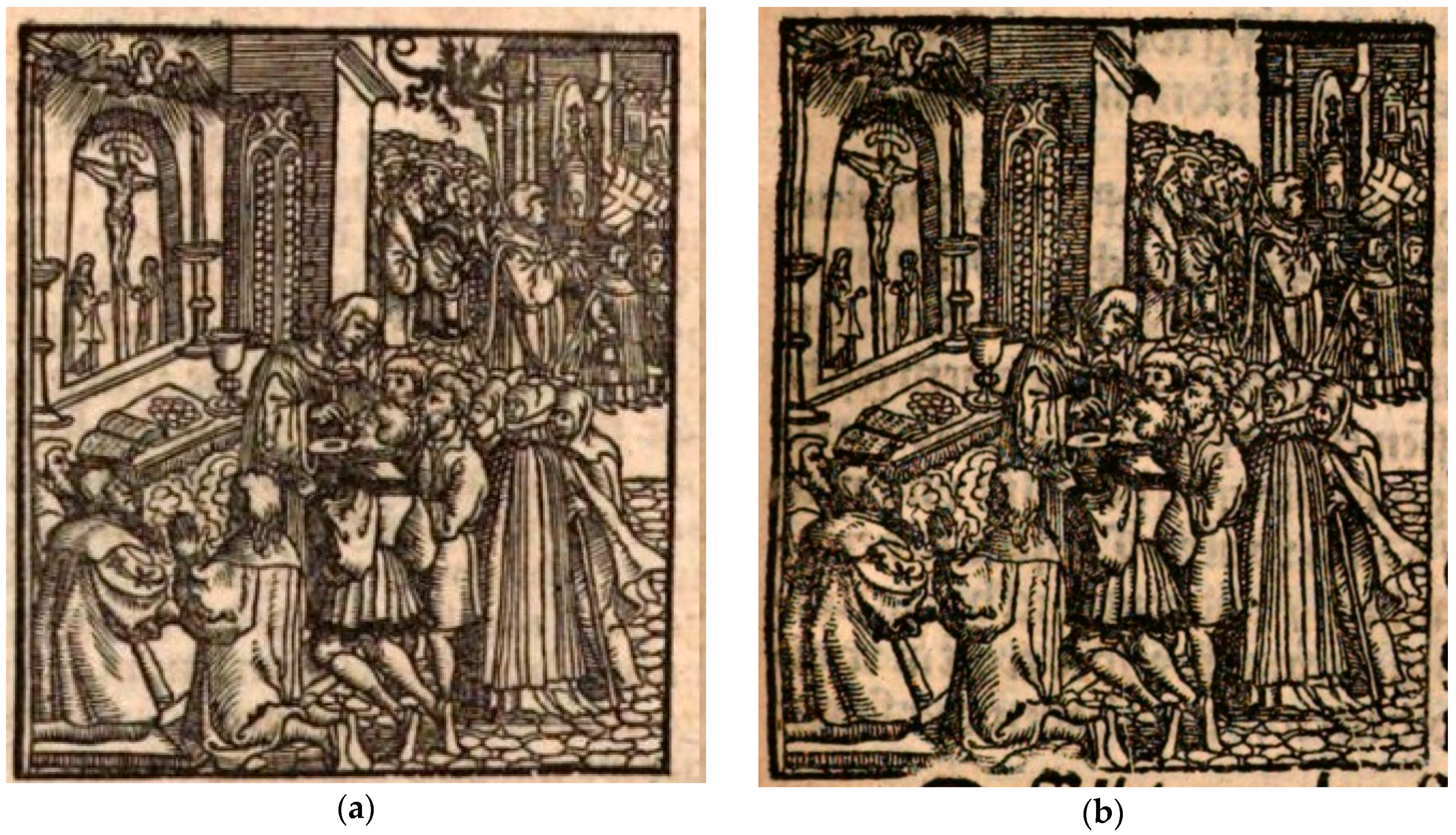
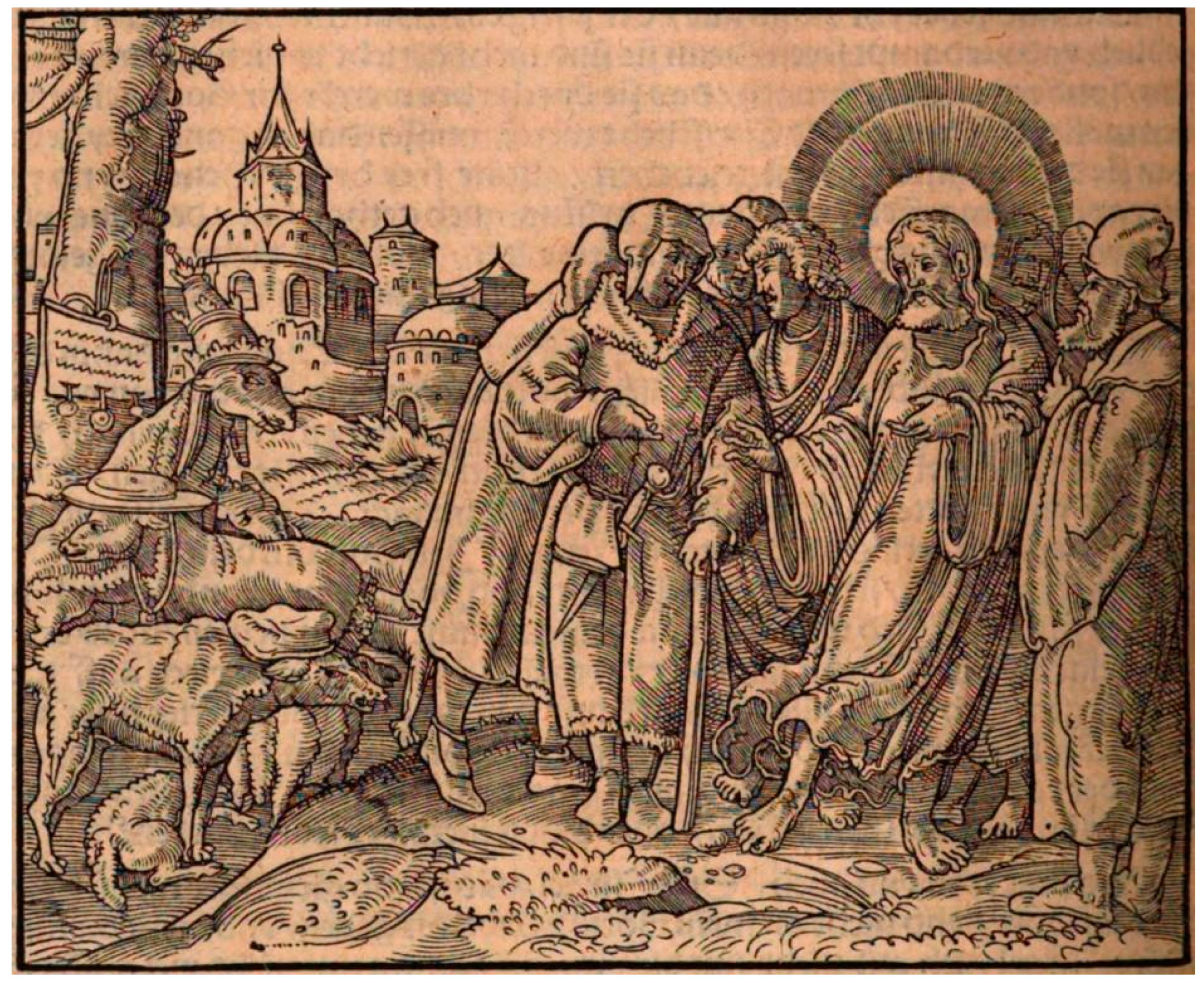

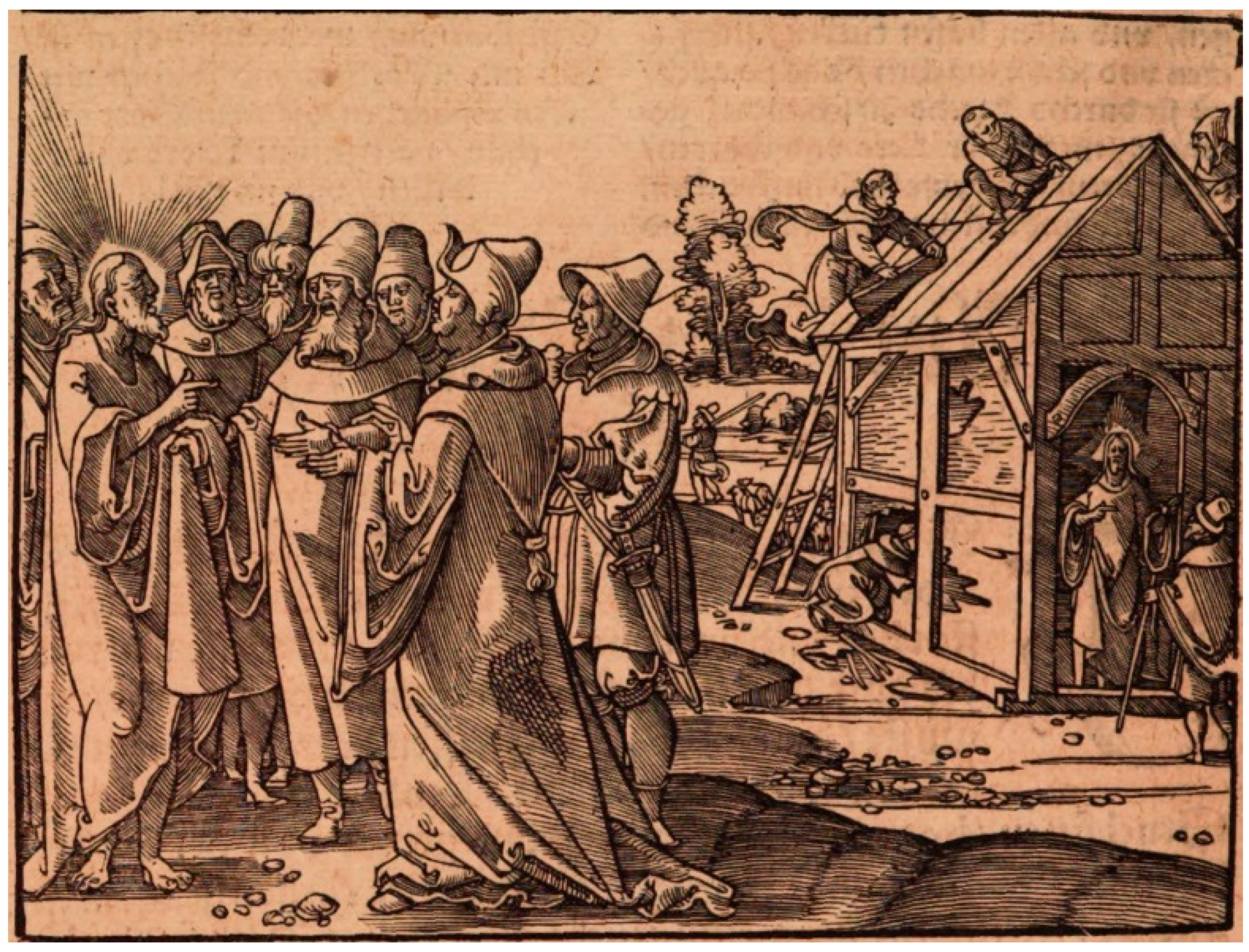

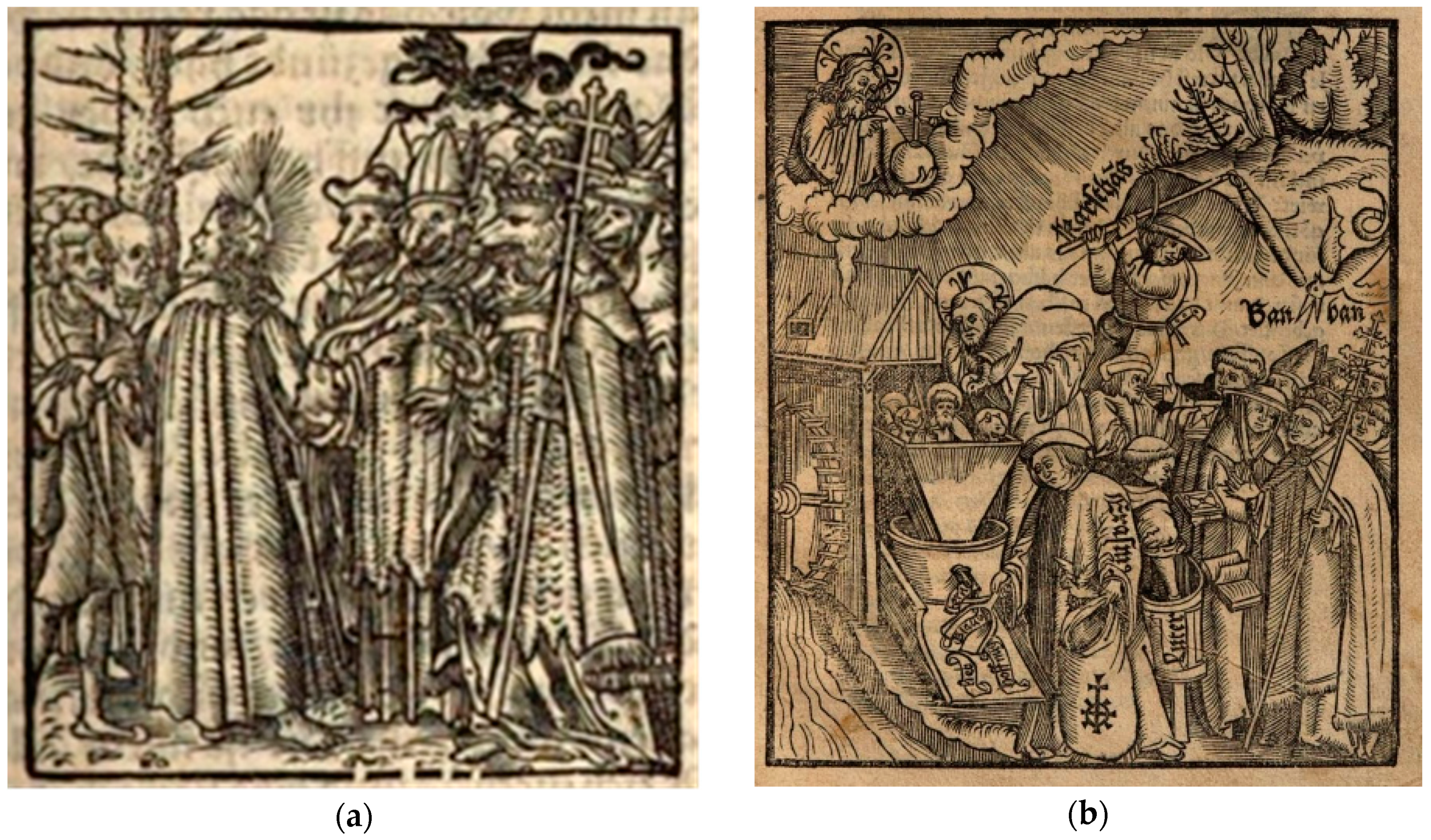
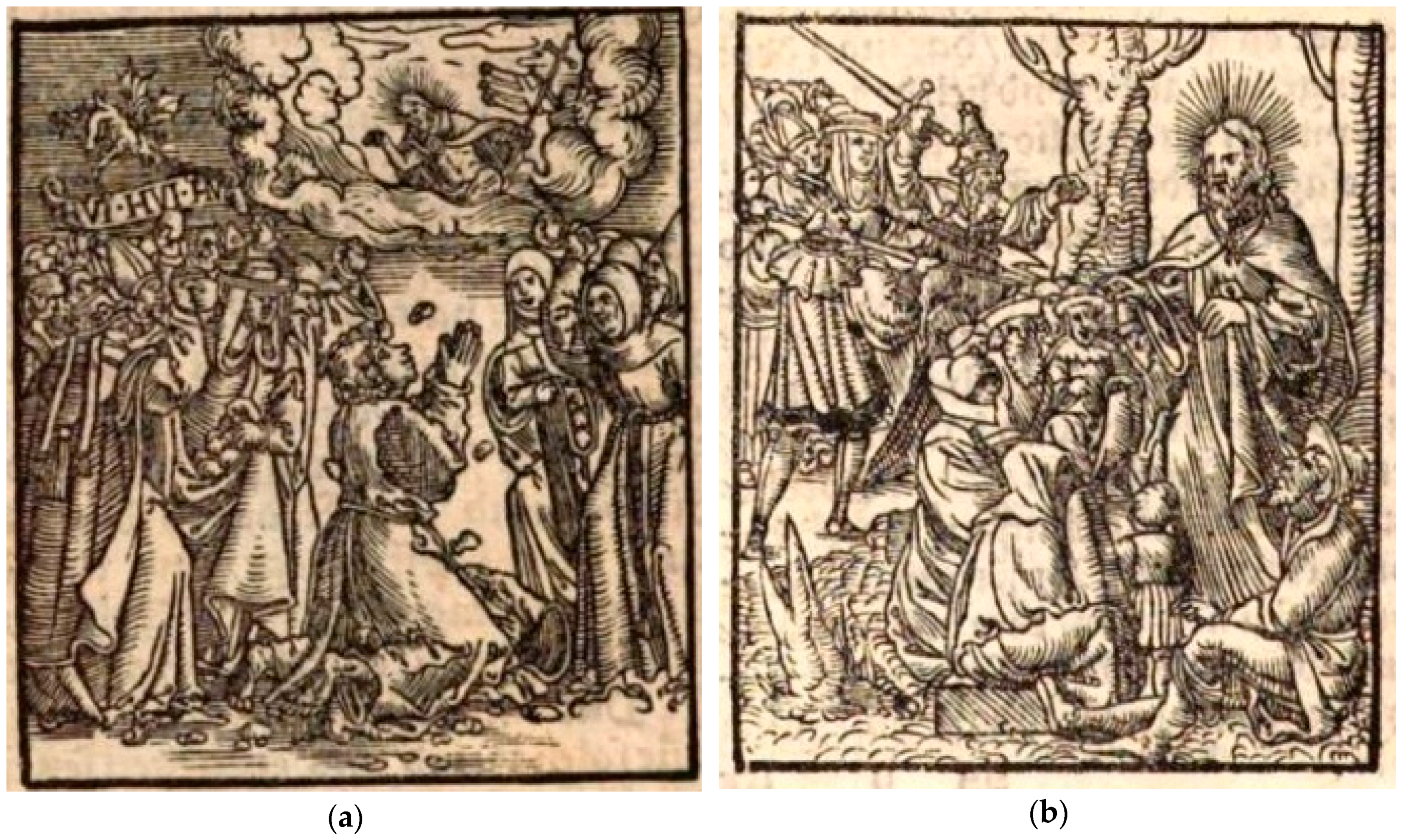
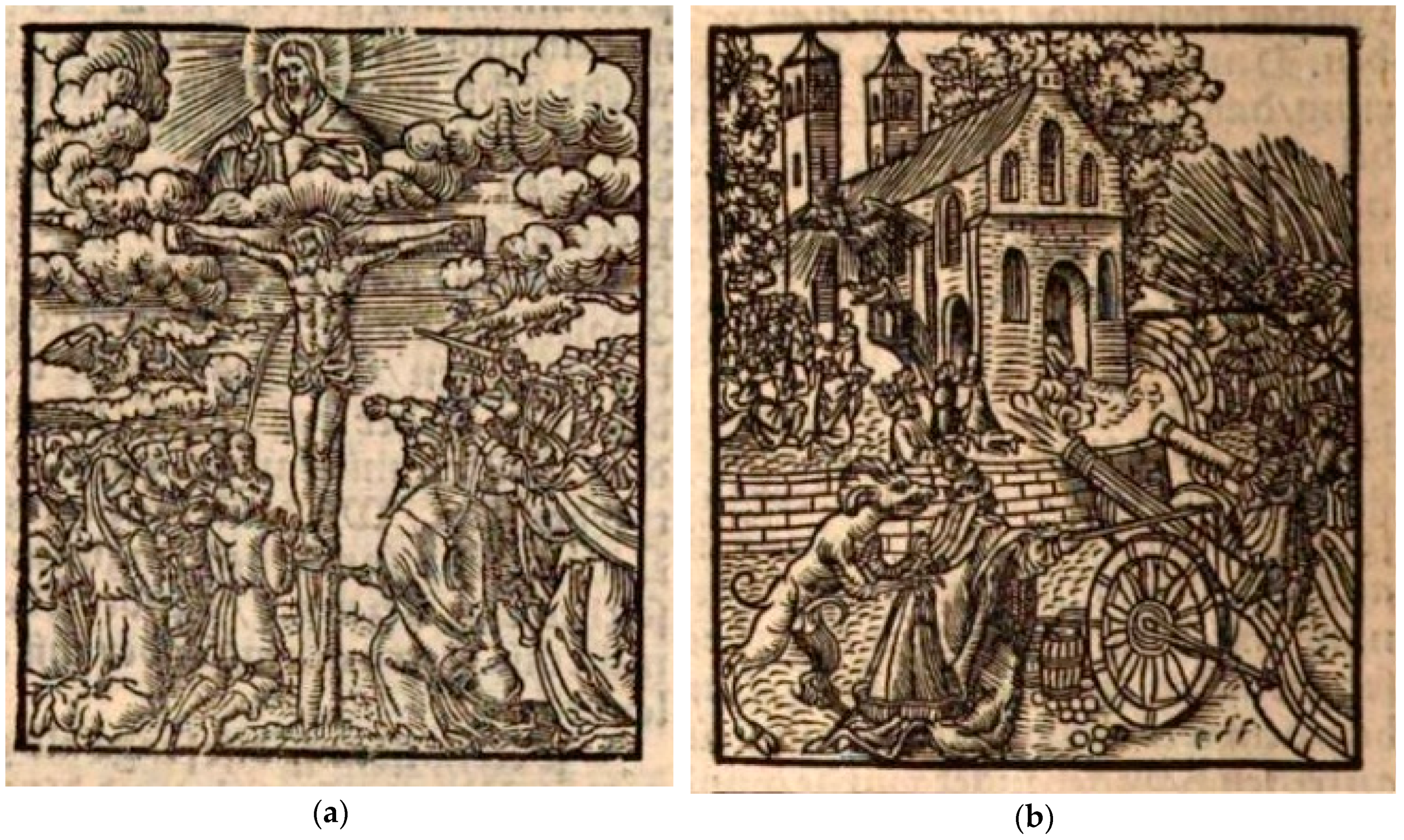
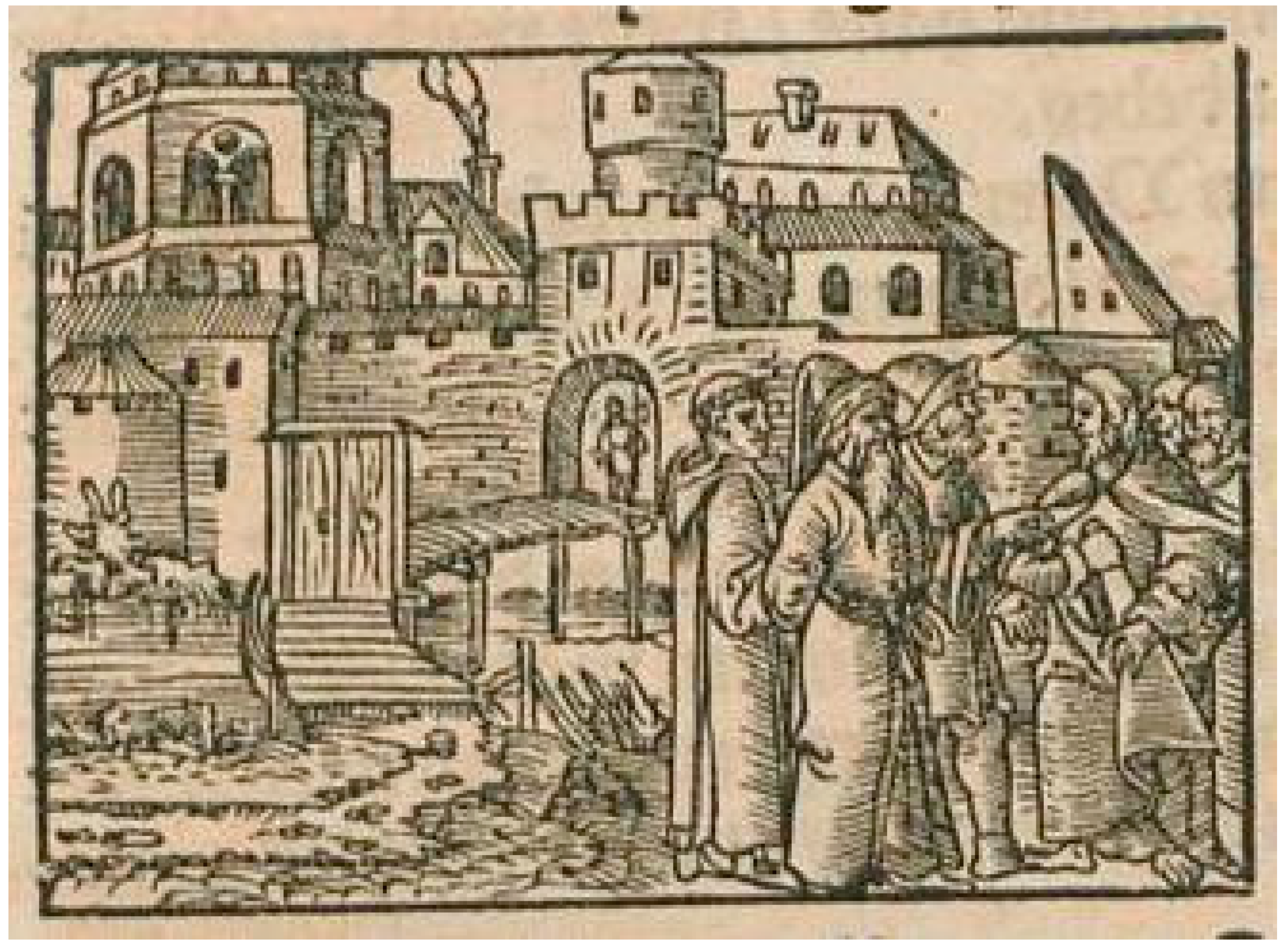
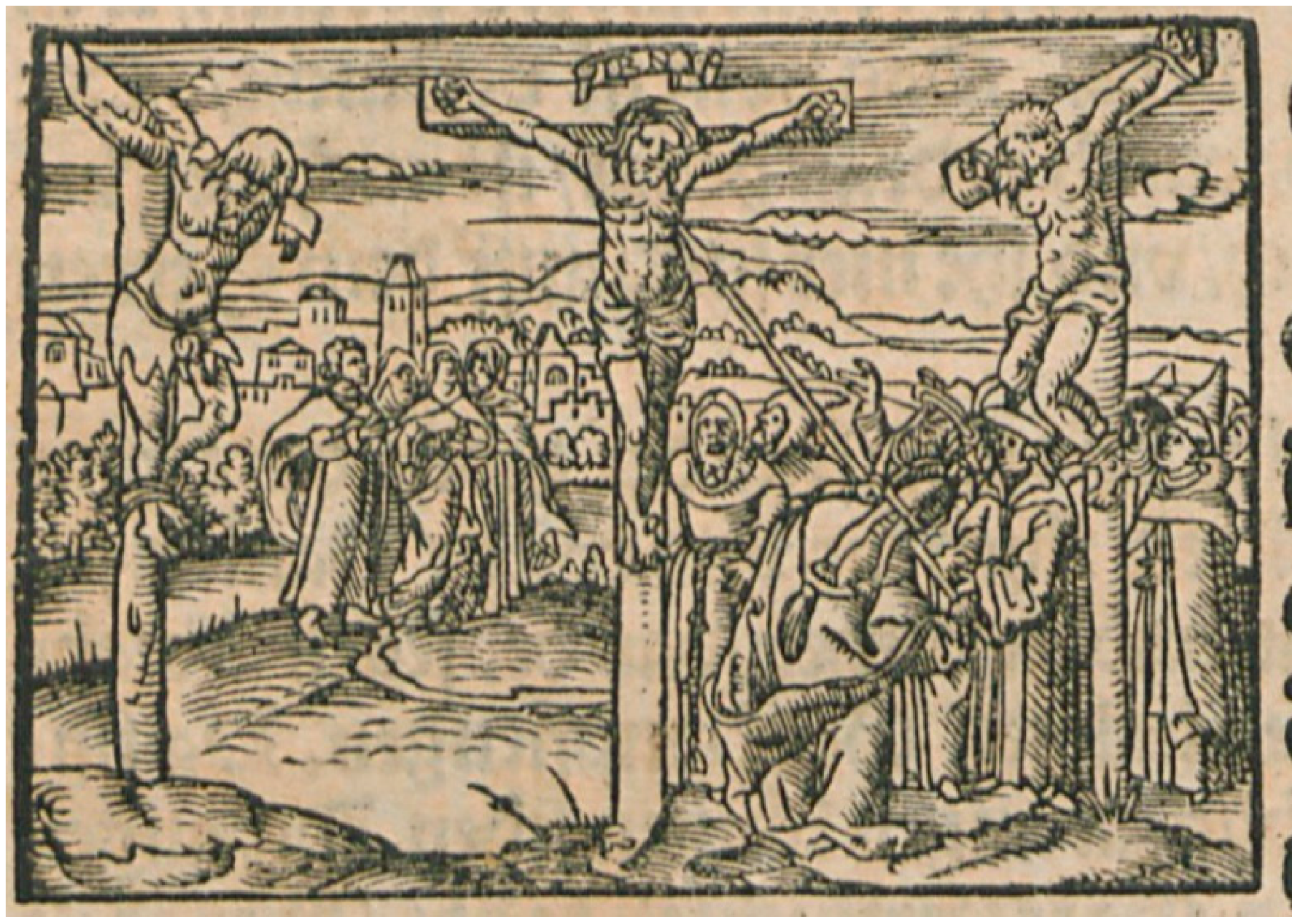
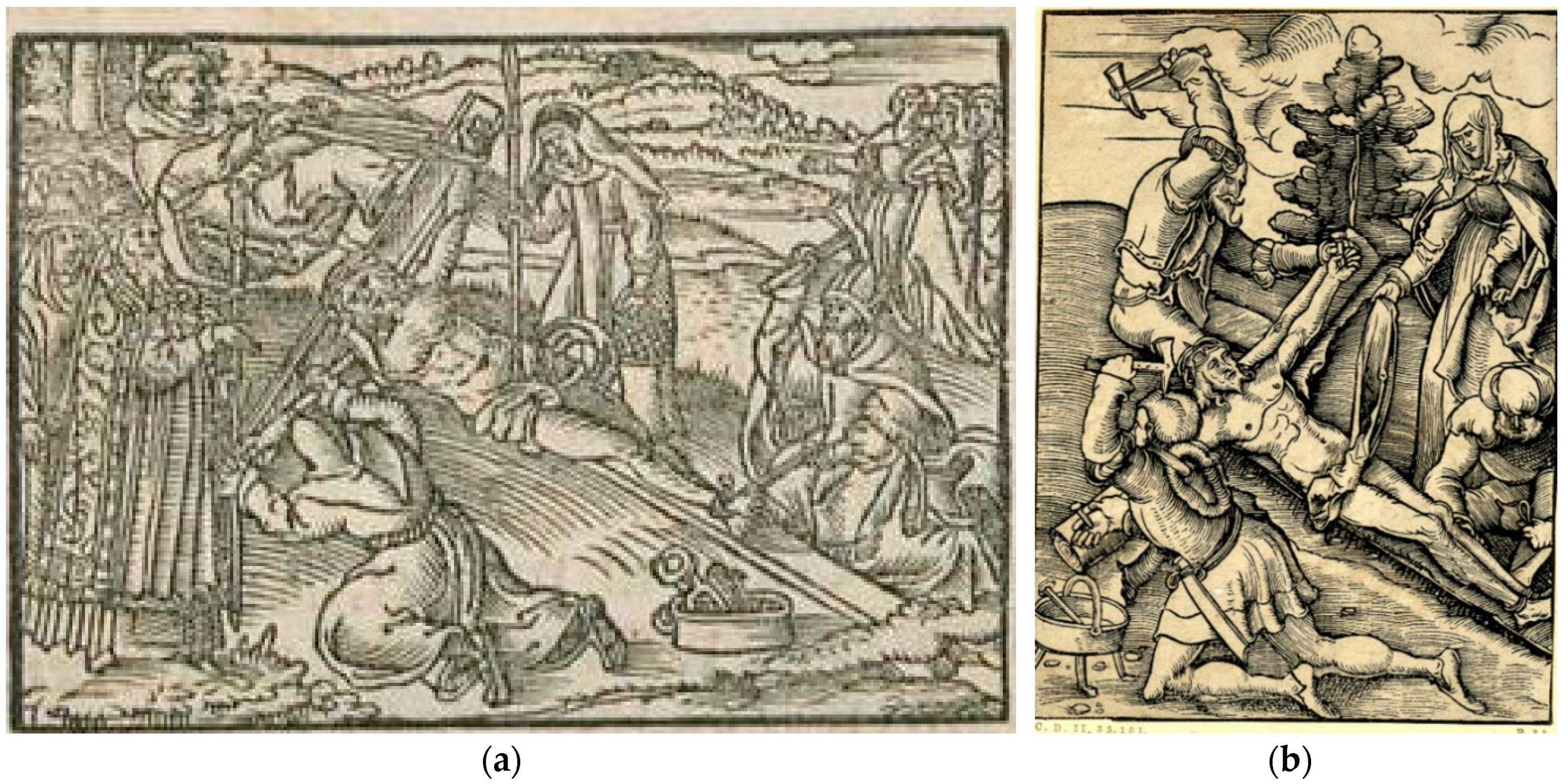
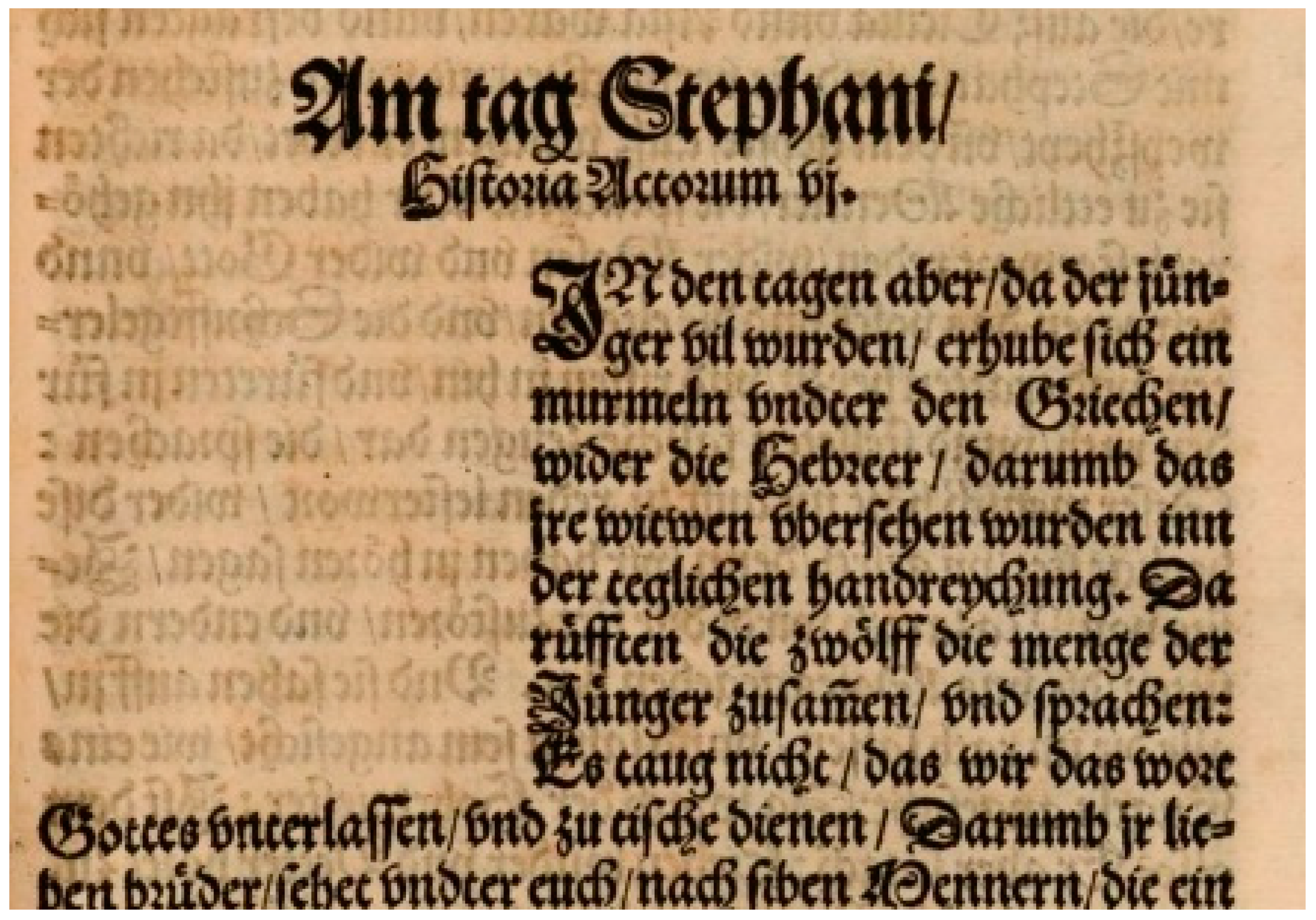
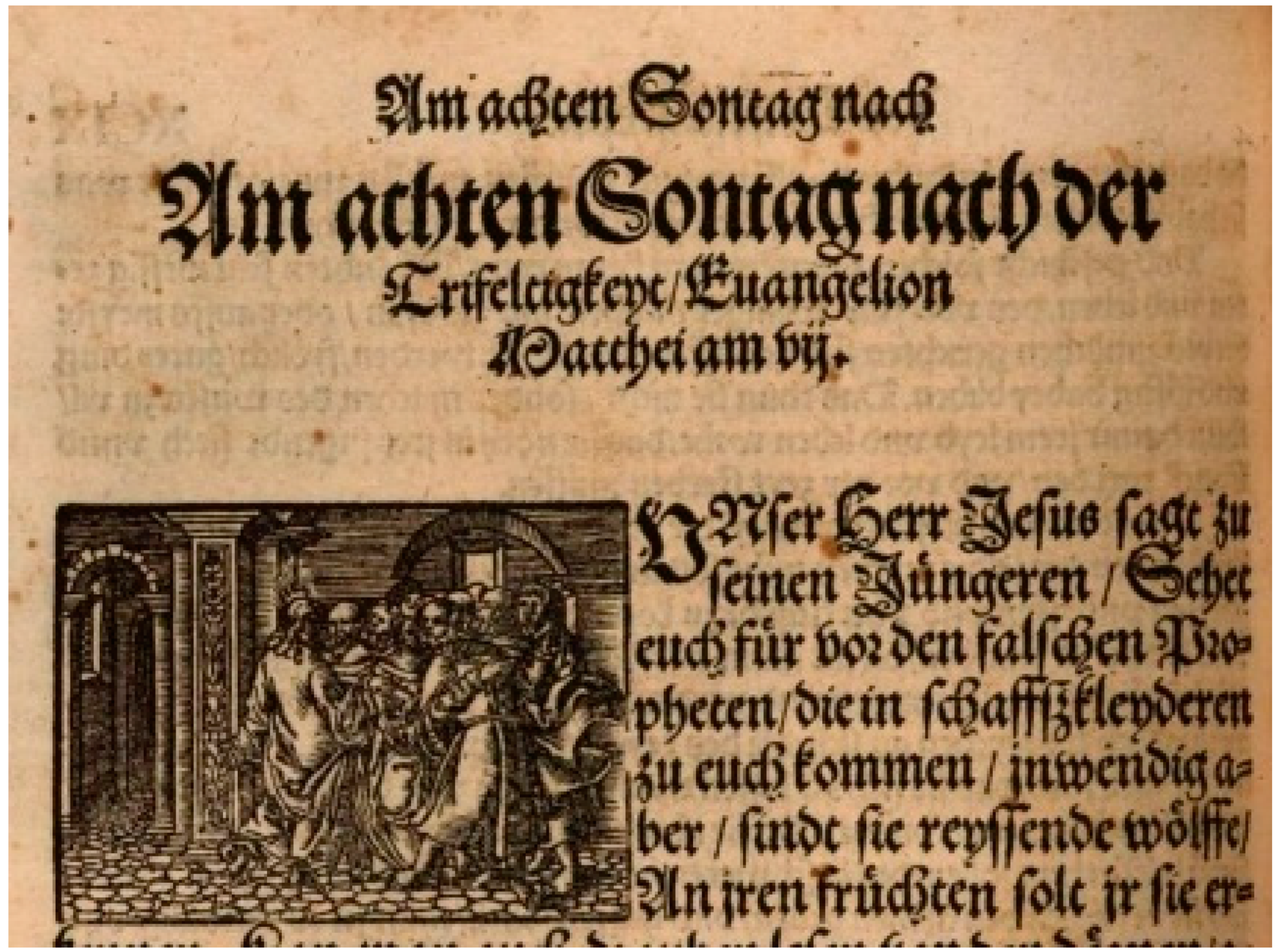
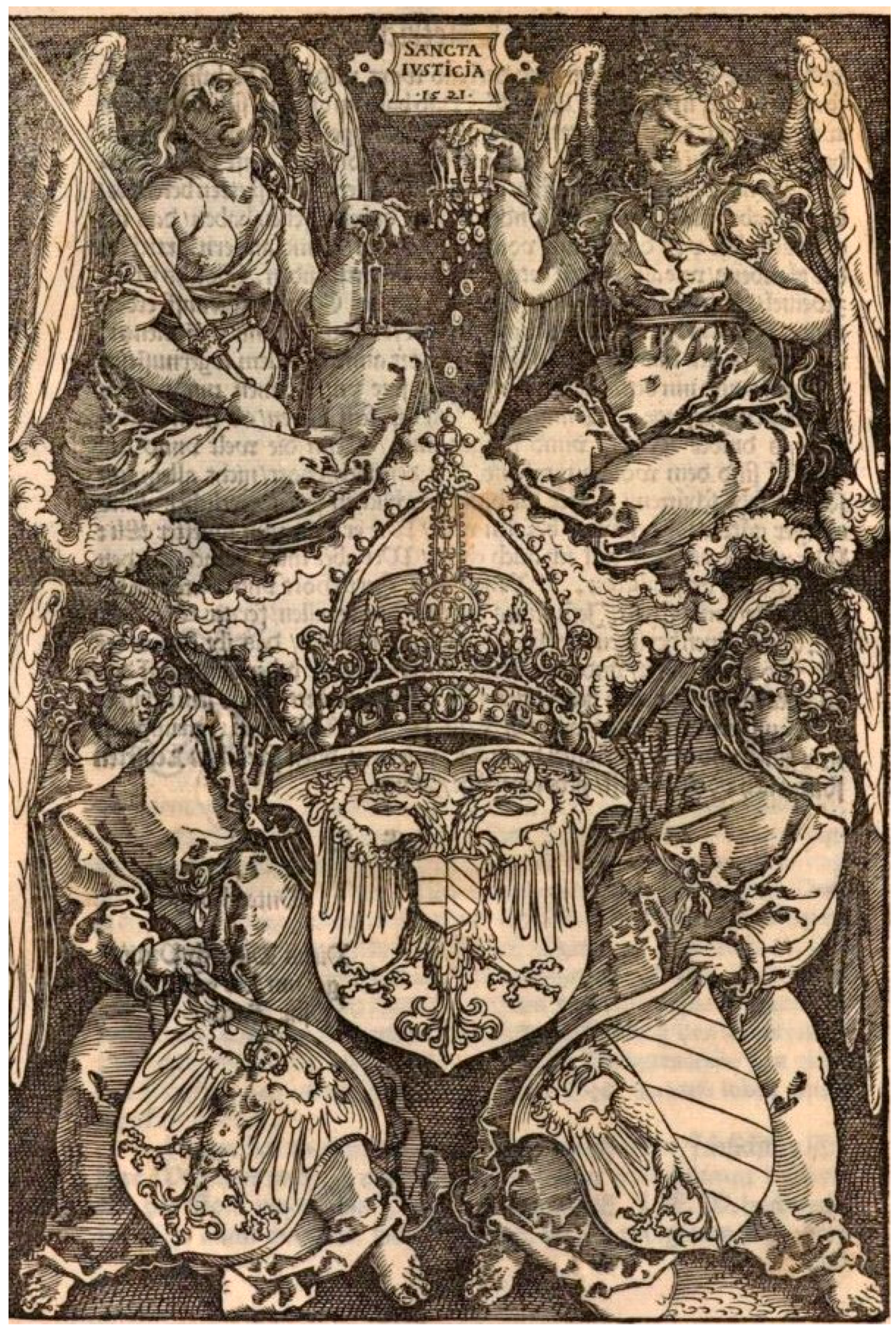
Publisher’s Note: MDPI stays neutral with regard to jurisdictional claims in published maps and institutional affiliations. |
© 2020 by the authors. Licensee MDPI, Basel, Switzerland. This article is an open access article distributed under the terms and conditions of the Creative Commons Attribution (CC BY) license (http://creativecommons.org/licenses/by/4.0/).
Share and Cite
Jurkowlaniec, G.; Ptaszyński, M. Anticlerical Motifs in the Illustrations of Martin Luther’s Hauspostille. Religions 2020, 11, 633. https://doi.org/10.3390/rel11120633
Jurkowlaniec G, Ptaszyński M. Anticlerical Motifs in the Illustrations of Martin Luther’s Hauspostille. Religions. 2020; 11(12):633. https://doi.org/10.3390/rel11120633
Chicago/Turabian StyleJurkowlaniec, Grażyna, and Maciej Ptaszyński. 2020. "Anticlerical Motifs in the Illustrations of Martin Luther’s Hauspostille" Religions 11, no. 12: 633. https://doi.org/10.3390/rel11120633
APA StyleJurkowlaniec, G., & Ptaszyński, M. (2020). Anticlerical Motifs in the Illustrations of Martin Luther’s Hauspostille. Religions, 11(12), 633. https://doi.org/10.3390/rel11120633




